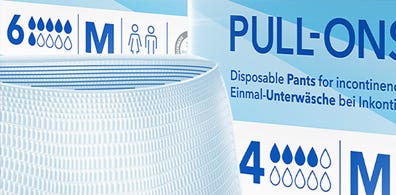Driving Personalised Patient Care with Cost Savings & Waste Reduction through Continence Champions in Care Homes



This case study reviews the role of Continence Champions in promoting best practices in continence care within a care home setting. The recommendations from Attends’ 2023 observational study were implemented at an 85-bed care home that provides person-centred care to residents with varying conditions, including dementia, frailty, physical disabilities and palliative care.
How did we achieve this?
Following the recommendations from the observational study, Attends introduced the role of Continence Champions in the care home. Continence Champions are trained Nurses or Senior Healthcare Assistants responsible for overseeing the assessment and management of incontinence using Attends products. They ensure that the right products are chosen for each resident and offer guidance on proper product use.
The Continence Champions were tasked with:
- Educating staff on the Attends product range and appropriate product usage.
- Ensuring the Product Selector Tool is kept up to date and prescribed products are used.
- Providing support to staff and ensuring correct product use.
Research shows that Continence Champions are effective in driving positive changes (Miech et al, 2018).
An initial meeting was held with the Care Home Owner, Nurse Manager and In-House Trainer to identify suitable Continence Champions. A tailored training plan was implemented, covering product assessments, product selection, fitting techniques and the importance of using the wetness indicator. The training also emphasised that products can be reapplied if they contain only small amounts of urine. This approach is designed to improve care while reducing the overall cost of incontinence products without compromising on quality.
Challenges & Overcoming Resistance
As with any new initiative, the introduction of Continence Champions was initially well-received. However, there was some resistance from a small minority of staff who were hesitant to switch residents from high absorbency XL all-in-one products to products that better suited their needs based on their urine output and using the correct size of Slip based on their hip and waist measurement. Additionally, there was reluctance to transition from Attends Pull-Ons products to a 2-piece system, which is recommended in the Guidance for the Provision of Absorbent Pads for Adult Incontinence.
To address this resistance, Attends provided ongoing support and additional training to staff, helping them to understand the benefits of using the right product for each individual resident.
Results
With the support of Attends and the Continence Champions, all residents were reassessed, and products were selected based on their individual needs for containment, comfort, discretion and dignity. This has led to a 33% reduction in the overall cost of continence products, with monthly expenditure dropping from £4,000 to £2,667. Additionally, waste disposal costs have been reduced by 50%, from £2,000 to £1,000 per month, thanks to proper product selection, which has minimised unnecessary waste. Continence Champions continue to receive regular updates and training from Attends, ensuring best practices are maintained. Residents are reassessed every six months, unless there is a change in their continence needs.
Attends products have been an absolute asset to our home care services here in Maryland. The ease of use and the level of protection provided by these products give both caregivers and patients peace of mind. We’ve seen a reduction in skin irritation and fewer instances of leaks, which has been crucial in maintaining the quality of life for our elderly patients.
Raymond, Continence Champion at Maryland Healthcare
Long-Term Benefits
The implementation of Continence Champions brings lasting improvements in care and operational efficiencies. Ongoing staff training on best practices ensures high standards of care while adapting to residents' changing needs. By focusing on appropriate product selection, the care home achieves cost savings, reduces waste and minimises environmental impact. The Continence Champion model helps continuous improvement, empowering staff to make informed decisions and proactively address challenges. Over time, this results in better resident satisfaction, improved care outcomes and a more streamlined approach to continence management. The model is also scalable, offering potential for wider adoption across other care homes or healthcare settings.
Going Forward
Attends will continue to provide training and support, recognising that ongoing education is important for maintaining best practice (Castle, 2009). The Continence Champions have proven to be invaluable in managing the provision of containment products and it is essential that replacements are identified promptly when Champions leave the team. This ensures continuity of care and the consistent application of best practices.
Conclusion
This case study highlights the benefits of implementing Attends’ recommendations through the role of Continence Champions. By providing specialised training and ongoing support, Attends has helped to streamline incontinence care, ensuring the selection of the right product for each resident’s needs. The resulting cost savings, improved product use and enhanced resident comfort demonstrate the value of this approach in care homes. With the continued support of Attends and the commitment of care home staff, this model is poised to lead to lasting improvements in both care quality and operational efficiency.
For more information on how Continence Champions can support your care home or facility, contact us today.
I appreciate the fact that Attends offers a wide selection, allowing us to choose the right product for each patient's unique needs. We’ve been using these products for some time now, and they’ve made a noticeable difference in both the quality of care and the satisfaction of our patients.
Kellie, Continence Champion at Maryland Healthcare
References
- Castle NG. Perceived Advantages & Disadvantages of Using Agency Staff Tool. Br J Community Nursing. 2013;18(12):580–587.
- Association for Continence Advice Consensus Guidelines Group. Guidance for the Provision of Absorbent Pads for Adult Incontinence: A Consensus Document. Version 19. 2021.
- Miech EJ, Rattray NA, Flanagan ME, Damschroder L, Schmid AA. Inside Help: An Integrative Review of Champions in Healthcare-Related Implementation. Sage Open Medicine. 2018.

Sexual Health & Incontinence

Which Medications Can Cause Incontinence?

Incontinence in Young Women: Key Causes

Nocturia & Nocturnal Enuresis (Adult Bedwetting)

How To Stop Urine Leakage When Coughing



